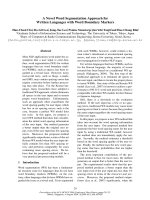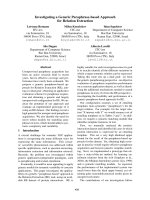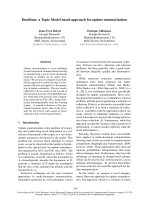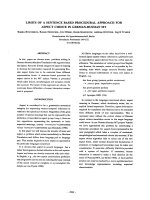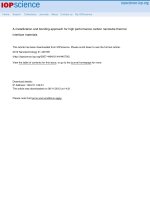a data-driven fuzzy rule-based approach for studentacademic performance evaluation
Bạn đang xem bản rút gọn của tài liệu. Xem và tải ngay bản đầy đủ của tài liệu tại đây (415.24 KB, 40 trang )
A Data-Driven Fuzzy Rule-Based
Approach for Student
Academic Performance Evaluation
Ernest Wu
Paper Reading
Outline
Basic concepts of academic performance
evaluation.
Basic concepts of Fuzzy Rule-Based System
demonstration
Data Driven FRBS
Subsethood-Based Rule Generation
Algorithm (SBA)
Weighted Subsethood-based Rule
Generation Algorithm
衡量學業表現的原因
可以對學生的表現有更多瞭解
老師可以藉此給予學生幫助
學生也可以因此克服弱點,或是成為進步的誘因
藉由學業表現對學生作出相應的決策
學生成績不好,重修或留級
也能用來衡量老師的表現
老師對學生表現的幫助有多少
衡量學業表現的方式
Formative assessment
著重在教授的”過程”
日常的活動:平時表現、平時報告、小考
Summative assessment
最後總結的成績
通常都會綜合以上兩者
面對不同的衡量目標,採行不同的方式
Formative assessment可以提供feedback
更全面的瞭解
Assessment Components (method)
Series of tests and quizzes
Portfolios
Formal written examinations
Individual Assignments and Coursework
Group work
Observation
Theses and publishable materials
Posters and oral presentation
衡量學業表現的表示法
Single letter-grade (A, B, C, D, E, F)
Nominal score (1, 2, …, 10)
Single numerical score (100 percent)
Linguistic terms ("Pass" and "Fail“)
GPA (0.00~4.00)
目前來說,使用數值資料表示法來作進一步統計計算比較普遍。
階層式的衡量法
各種的assessment components,可以使用階
層的方式,將它們匯總起來。
新方法產生的原因
確認傳統衡量方式是否有問題。
傳統方式無法面對不確定的評分,然而老師打分數本
來就是大概,因此使用fuzzy concepts可以面對這種
狀況。
傳統方式只能處理數值資料,對於自然語言或是含糊
的詞彙比較不能處理,若能使用自然語言將會讓衡量
更有彈性。
傳統方式缺乏比較的資訊 (與他人或自己比較)
criterion-reference evaluation
Æ
norm-referenced evaluation (Z-Score)
使用兩者的Combination以得到更多的資訊
使用Fuzzy Rule-Based System (FRBS)
新增的衡量方式
Fuzzy Rule-Based System
Fuzzy set Theory
Fuzzy membership functions
Fuzzy logical operators
Fuzzy IF-THEN rules
Fuzzy set theory
傳統set theory—everything is precise
Fuzzy set theory
Fuzzy Membership Functions
measure linguistic variable
A linguistic variable is defined as a variable whose values
are words or sentences in a natural or synthetic language
choosing or generating an appropriate fuzzy membership
function to represent a linguistic term is very important.
Fuzzy Logical Operators
Traditional logical operators
Complement Æ negation
Intersection Æ conjunction
Union Æ disjunction
Fuzzy Logical Operators(2)
Fuzzy Negation:
Fuzzy Conjunction (t-norm):
Fuzzy Disjunction (t-conorm):
Min-Max operators have been used widely probably because of their simplicity.
Fuzzy IF-THEN Rules
“IF x is A THEN y is B" where A and B are
fuzzy sets.
fuzzy IF-THEN rules are production rules
whose antecedents, consequences or both
are fuzzy.
linguistic fuzzy model
Mamdani-type FRBS
Takagi-Sugeno-Kang (TSK) type FRBS
Fuzzy IF-THEN Rules(2)
條件規則:IF 溫度 is A, THEN 壓縮機 is B
狀態:溫度 is 高
動作:壓縮機 is 打開
其中A、B為模糊集合。IF的部分稱為前件部,而
THEN的部分則稱為後件部。
Mamdani-type FRBS
Demonstration
Traditional decision tree- training set
NoStrongHighMildRain
YesWeakNormalHotOvercast
YesStrongHighMildOvercast
YesStrongNormalMildSunny
YesWeakNormalMildRain
YesWeakNormalCoolSunny
NoWeakHighMildSunny
YesStrongNormalCoolOvercast
NoStrongNormalCoolRain
YesWeakNormalCoolRain
YesWeakHighMildRain
YesWeakHighHotOvercast
NoStrongHighHotSunny
NoWeakHighHotSunny
play ballWindHumidityTemperatureOutlook
Traditional decision tree- generate tree
Outlook = Overcast: Yes (4.0)
Outlook = Sunny:
| Humidity = High: No (3.0)
| Humidity = Normal: Yes (2.0)
Outlook = Rain:
| Wind = Weak: Yes (3.0)
| Wind = Strong: No (2.0)
Traditional decision tree- testing
Outlook: Sunny, Humidity: Normal
Decision:
Yes CF = 1.00 [ 0.50 - 1.00 ]
Traditional decision tree- generate rules
Rule 1:
Outlook = Sunny ,Humidity = High
-> class No [63.0%]
Rule 5:
Outlook = Rain , Wind = Strong
-> class No [50.0%]
Rule 3:
Outlook = Overcast
-> class Yes [70.7%]
Rule 2:
Humidity = Normal
-> class Yes [66.2%]
Rule 4:
Outlook = Rain, Wind = Weak
-> class Yes [63.0%]
Data Driven FRBS with WSBA method
Training Dataset
Testing Set


